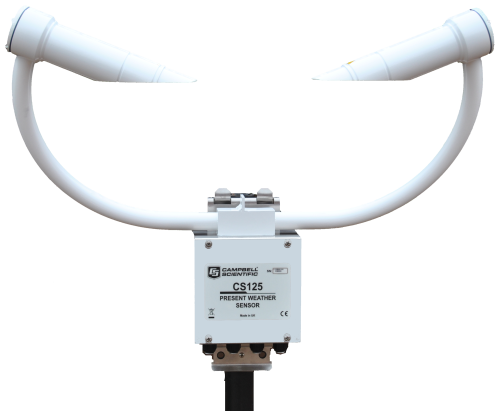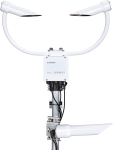
Ideal para aviación y transporte






Resumen
El CS125 es un sensor de visibilidad y tiempo presente por infrarrojos de dispersión frontal para usarse de forma autónoma o como parte de una estación meteorológica en aplicaciones para aeropuertos, carreteras o marinas. El CS125 incluye 5m de cable con conector DB9.
Learn more about our CampbellAero™ Automated Weather Observing System (AWOS) Solution and our CampbellAero Software.
Leer másVentajas y características
- Sensor de alto rendimiento a precio competitivo
- Disponible extensión garantía de 3 años
- El diseño del sensor minimiza la interrupción del flujo de aire en el volumen de medición
- Calibración en campo mediante kit de calibración opcional
- Bajo consumo - adecuado para aplicaciones remotas
- Chequeo estado automático de fallos o contaminación ventana
- Incluye calentadores en cabezales (hood) y lentes (dew) para funcionamiento en todo tipo de condiciones meteorológicas
- Fabricado en UK
- Certificado para uso aeronáutico por el German Meteorological Service DWD
Imágenes



Descripción detallada
El CS125 utiliza el conocido sistema de dispersión (scattering) de 42º para la medición de la visibilidad, que ofrece estimaciones precisas de Meteorological Observable Range (M.O.R.) para niebla y nieve.
En él se identifican las partículas de precipitación de sus propiedades de dispersión y las velocidades de caída, y combina los datos con una medición de temperatura para poder identificar el tipo de clima. Se ha apuntado hacia abajo la óptica para reducir el riesgo de contaminación de las lentes y el bloqueo por nieve.
La interferencia con el volumen de la muestra del sensor por la distorsión de flujo o de calor se reduce al mínimo.
También proporciona información sobre el tiempo presente fiable en forma de códigos SYNOP incluida la información sobre la intensidad de la precipitación. También puede ser reportado el valor de la precipitación.
El CS125 utiliza el muestreo continuo de alta velocidad para reducir errores durante fenómenos meteorológicos mixtos y eventos que devuelven señales intermitentes, como la lluvia y el granizo, mientras que todavía proporciona lecturas fiables durante los eventos más estables, como la niebla y la niebla. El CS125 tiene una alta inmunidad a la interferencia de las luces de advertencia visibles e infrarrojas utilizadas para marcar obstáculos, como en las turbinas eólicas de los aerogeneradores.
El CS125 incorpora calentadores para poder prevenir el efecto de la condensación en las lentes y de serie también calentadores anti heladas de alta potencia. Estos calentadores se controlan automáticamente para poder asegurar el funcionamiento en todas las épocas, o se pueden desactivar de forma individual para ahorrar energía.
El CS125 supervisa continuamente su propio estado y reportará los fallos internos y la contaminación o bloqueo de las lentes de los sensores. También cuenta con dos salidas de alarma configurables por el usuario que se pueden utilizar para activar alarmas sonoras o visuales que utilizan relés de estado sólido.
Sensor certificado por la agencia Meteorológica de Alemania (Deutscher Wetterdienst) como adecuado para su uso en el control de los sistemas de luz de obstrucción de aerogenerador según las especificaciones 506/04 (General Administrative Rules for the Identification of aircraft Obstructions).
Especificaciones
Operational |
|
| Maximum Reported Visibility | 100 km (62.1 mi) |
| Minimum Reported Visibility | 5 m (16.4 ft) |
| Resolution | 1 m (3.28 ft) |
| Outputs | Present and past weather: identifies as standard mist, fog, drizzle, freezing drizzle, drizzle and snow, rain, freezing rain, rain and drizzle, rain and snow, and snow. 57 SYNOP present weather codes and associated METAR and NWS present weather codes - hail detection; past weather codes. |
| Accuracy |
|
| Precipitation Detection Sensitivity | 0.05 mm/h |
| Accumulation Reporting Range | 0 to 999.9 mm (0 to 39.37 in.) |
| Accumulation Accuracy | ±15% (against factory calibration standards in the laboratory, for liquid precipitation) |
| Accumulation Resolution | 0.1 mm (0.0039 in.) |
| Rain Intensity Range |
0 to 999.9 mm/h (0 to 39.37 in./h) (The maximum intensity reported is dependent on the mixture of precipitation falling.) |
| Intensity Accuracy | ±15% (against factory calibration standards in the laboratory, for liquid precipitation) |
| Intensity Resolution | 0.01 mm/h (0.00039 in./h) |
| Operating Temperature Range | -25° to +60°C (standard) |
| Extended Operating Temperature Range | -40° to +70°C (This extended version is available as a special. Contact Campbell Scientific for more information.) |
| Operating Humidity | 0 . . . 100% |
| Operating Wind Speed | Up to 60 m/s |
| Sensor Sealing | Rated to IP66 |
| Total Unit Power | Less than 3 W while sampling continuously (including dew heaters) |
Mechanical |
|
| Material | Stainless steel and hard-anodized aluminum powder-coated |
| Mountings | Stainless-steel clip on V-bolt mounting to pole with diameter of 32 to 52.5 mm (1.26 to 2.07 in.) |
| Mounting Pole | An optical mounting pole is available to place the sample volume at 1.5 m (4.9 ft), as recommended by the WMO. |
| Frangible Mast | Frangible masts are available to customer requirements to meet ICAO recommendations (typically placing the sample volume at 2.5 m [8.2 ft]). |
| Visibility Sensor Dimensions | 540 x 640 x 246 mm (21.26 x 25.2 x 9.7 in.) including mount |
| Cable Length | 5 m (16.4 ft) |
| Sensor Weight | ~3 kg (6.61 lb) dependent upon mounting system |
Electrical |
|
| -NOTE- |
Lower power states can be achieved by less frequent sampling and remote control of heaters. Optional power supplies with battery backup available. Connectors in place of flying leads are available. A low-voltage shutdown level can be set to prevent backup batteries from being damaged. |
| Electronics Supply Voltage | 7 to 30 Vdc |
| Hood Heater Supply Voltage | 24 V (dc or ac) |
| Hood Heater Power | 2 x 30 W (total of 60 W) |
| Dew Heater Power | 2 x 0.6 W (total of 1.2 W) |
Interface |
|
| Serial Interface | RS-232 or RS-485 |
| Serial Data Rates | 1200 to 115,200 bps (38,400 bps default rate) |
| Alarm Outputs | 2 x 0 to 5 V outputs, 32 mA (max) |
Optical |
|
| -NOTE- |
Lens contamination circuity monitors both the source and detector lenses for contamination/blockage at 1 s intervals. The sensor can be configured to adjust calibration for low to moderate window contamination. Light source stability control ensures stable operation through variations in temperature and with sensor aging. Corrected at 1 s intervals. |
| Emitter Light Frequency | 850 nm |
Documentos
Folletos producto
Manuales
Documentos técnicos
Casos de aplicación
Conformidad
Misceláneo
Videos & Tutoriales
Descargas
CR1000X CS125 example programs v.1 (10 KB) 18-03-2020
CR1000X programs that read continuous data and polled data and use the SET, SETNC, and GET commands. The program that uses the SETNC command powers the CS125 hood heaters when needed according to the dew point. A HygroVUE5 Air Temperature and Relative Humidity Sensor provides the measurements used in the dew point calculation.
CS125 and CS120A OS v.17 (555 KB) 08-06-2023
Campbell Scientific has introduced a new operating system, OS 17, for the CS120A visibility sensor and CS125 present weather sensor. It is backwards compatible and is easily installed on all CS120A and CS125 sensors (but not older CS120 sensors). OS 17 is available free of charge and can be downloaded here or supplied by email on request.
Upgrade to OS 17 is recommended.
Casos de aplicación
Background Manitouwadge Municipal Airport is located 48 km (29.8 mi) north of highway 17 on Highway......leer más
Tropical volcanic islands are biodiversity hotspots where the Critical Zone (CZ) remains poorly studied. In......leer más
Exeter Airport is undergoing a huge refurbishment to expand their capabilities and streamline their operations......leer más
Campbell Scientific’s system integrator, AUDIMOBIL LDA, recently upgraded the airport weather system in the S.......leer más
The Utah Department Of Transportation (UDOT) operates a network of roadside weather stations across the......leer más
AUDIMOBIL recently installed an Automatic Weather Station in a Portuguese Military Air Base, to support......leer más








